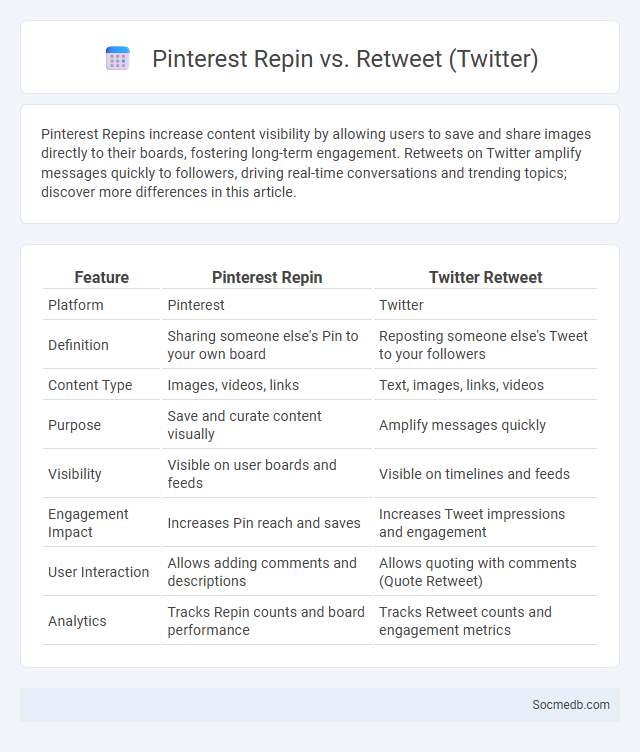
Photo illustration: Pinterest Repin vs Retweet (Twitter)
Pinterest Repins increase content visibility by allowing users to save and share images directly to their boards, fostering long-term engagement. Retweets on Twitter amplify messages quickly to followers, driving real-time conversations and trending topics; discover more differences in this article.
Table of Comparison
| Feature | Pinterest Repin | Twitter Retweet |
|---|---|---|
| Platform | ||
| Definition | Sharing someone else's Pin to your own board | Reposting someone else's Tweet to your followers |
| Content Type | Images, videos, links | Text, images, links, videos |
| Purpose | Save and curate content visually | Amplify messages quickly |
| Visibility | Visible on user boards and feeds | Visible on timelines and feeds |
| Engagement Impact | Increases Pin reach and saves | Increases Tweet impressions and engagement |
| User Interaction | Allows adding comments and descriptions | Allows quoting with comments (Quote Retweet) |
| Analytics | Tracks Repin counts and board performance | Tracks Retweet counts and engagement metrics |
Understanding Pinterest Repins, Retweets on Twitter, and Their Core Differences
Pinterest repins involve users sharing visual content to their own boards, enhancing content visibility through image-based curation, while retweets on Twitter allow users to redistribute text, images, or videos directly within a real-time conversation feed. The core difference lies in platform interaction: Pinterest emphasizes content discovery and collection over time, whereas Twitter prioritizes rapid information dissemination and engagement. Understanding these mechanisms helps marketers tailor strategies for visual influence on Pinterest and viral messaging on Twitter.
How Pinterest Repins Work: Key Features and User Behavior
Pinterest repins function as a core mechanism for content sharing, allowing users to save and distribute images or ideas from others to their own boards, boosting content visibility and engagement. Key features include the ability to replicate pins with added personal context, enhancing collaborative content discovery and viral potential across the platform. User behavior often involves strategic repinning based on popular trends, niche interests, and visual appeal, which drives traffic back to original sources and supports influencer marketing efforts.
What Is a Twitter Retweet? Functionality and Reach Explained
A Twitter retweet allows users to share someone else's tweet with their own followers, effectively amplifying the original message's reach. By clicking the retweet button, the tweet is reposted on the user's timeline, increasing visibility and engagement across the platform's 500+ million active users. Retweets play a crucial role in viral content dissemination, influencer marketing, and real-time information sharing on the Twitter network.
Comparing Viral Potential: Repin vs Retweet
Repin on Pinterest and Retweet on Twitter both amplify content reach, but their viral potential varies due to platform dynamics. Repins contribute to long-term content visibility within niche communities, leveraging Pinterest's algorithm that favors visually rich, evergreen content. Retweets enable rapid, real-time spread through Twitter's fast-paced, conversation-driven environment, often generating immediate but shorter-lived viral attention.
Audience Engagement: Pinterest Repin vs Twitter Retweet
Pinterest repins generate prolonged audience engagement by amplifying visual content within niche communities, fostering ongoing discovery and interaction. Twitter retweets create immediate, rapid dissemination of messages through followers' networks, enhancing real-time conversations and brand visibility. Understanding your audience's platform preferences helps optimize engagement strategies between Pinterest repins and Twitter retweets.
Visibility and Shelf Life: Which Shares Content Longer?
Social media platforms vary significantly in content visibility and shelf life, with Twitter offering rapid but short-lived exposure due to its fast, real-time feed, whereas Facebook and Instagram extend visibility through algorithms that resurface posts over days or weeks. LinkedIn posts often maintain engagement longer by targeting professional networks, allowing content to be discovered well beyond initial sharing. Understanding platform-specific content longevity enhances strategic communication for maximizing audience reach and sustained interaction.
Platform Algorithms: Impact of Repins and Retweets
Platform algorithms heavily influence the visibility of your content by prioritizing engagement metrics such as repins on Pinterest and retweets on Twitter. High numbers of these interactions signal relevance and quality to the algorithm, boosting your reach and driving organic growth. Understanding how these platforms weigh repins and retweets can help optimize your social media strategy for maximum impact.
Brand Strategy: When to Use Repin vs Retweet for Marketing
Understanding when to use Repin versus Retweet is crucial for optimizing your social media brand strategy. Repin on Pinterest is ideal for visually-driven content that enhances brand aesthetics and inspires your audience, while Retweet on Twitter amplifies timely messages, customer engagement, and real-time conversations. Your choice should align with the platform's strengths to maximize brand exposure and foster authentic connections.
Analytics: Measuring Repin and Retweet Performance
Measuring Repin and Retweet performance is essential for understanding content engagement across Pinterest and Twitter. Analytics platforms track metrics such as the number of repins, retweets, impressions, and user interactions, revealing how widely content is shared and the audience's interest level. These insights help optimize social media strategies by identifying high-performing posts and refining messaging to increase reach and engagement.
Best Practices: Maximizing Reach with Repins and Retweets
Maximizing reach on social media platforms like Pinterest and Twitter involves leveraging repins and retweets effectively by creating highly shareable, visually appealing content tailored to target audiences. Utilizing relevant hashtags, timing posts during peak engagement hours, and interacting with followers enhances visibility and encourages organic sharing. Monitoring analytics to identify popular content types and trends enables continuous optimization of strategies, boosting overall engagement and expanding audience reach.
 socmedb.com
socmedb.com